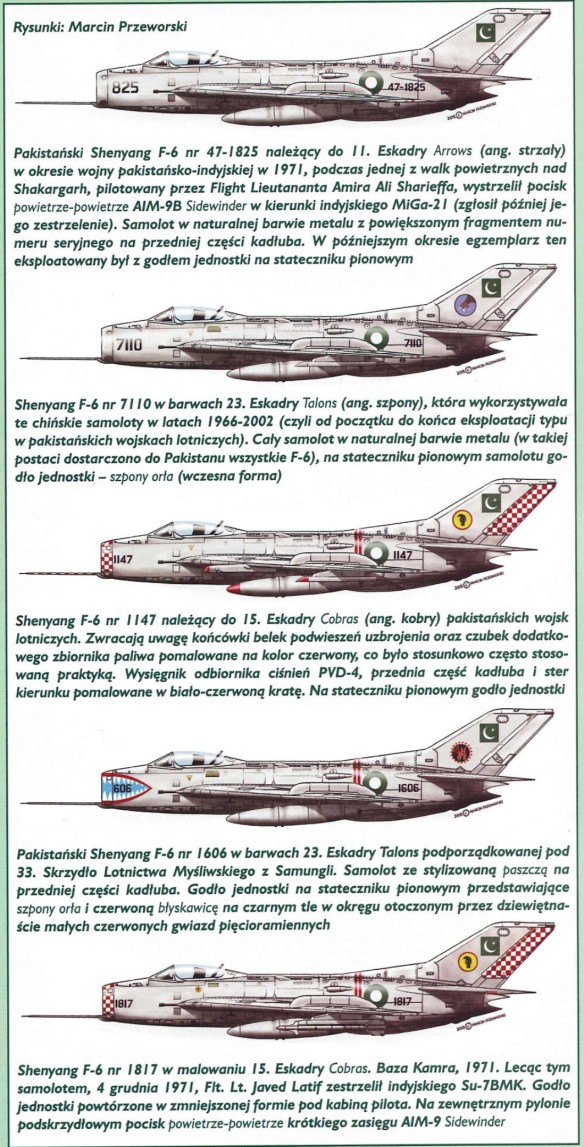
The expansion of the IAF, which had interfered with its performance in 1965, was over when war came in 1971. During the intervening years the IAF had received an infusion of large numbers of modern supersonic aircraft. The MiG-21 fleet which stood at half a dozen aircraft in 1965 had grown to eight squadrons. The Vampires of 1940s vintage had also been withdrawn.
Many squadrons of the Indian Air Force were over strength, since each squadron kept large numbers of maintenance reserves. The PAF had added F-6 (Chinese MiG-19s) and Mirage IIIs to its fleet. The PAF expansion and modernization program lagged far behind that of the IAF’s.
Pakistan Air Force – ORBAT 1971
Aircraft Type Squadron Nos.
One Mirage IIIEP squadron 5
Two B-57B squadrons 7 & 8
One F-104A squadron 9
Three F-6 squadrons 11, 23 & 25
Six F-86 Sabre squadrons 14, 15, 16, 17, 18 & 19
Service
The F-6 was flown by the Pakistan Air Force from 1965 to 2002, the aircraft design undergoing around 140 modifications to improve its capabilities in the interceptor and close air support roles. The PAF F-6 fighters participated in the Indo-Pak War 1971 against India, scoring approximately 6 confirmed aerial victories. The three Pakistani J-6 squadrons flew nearly a thousand sorties, during which the PAF lost 3-4 F-6 to ground fire and two to three in aerial combat. An F-6 was also lost to friendly fire. One of the F-6 pilots shot down was Wajid Ali Khan, who was taken as a POW and later became a Member of Parliament in Canada. The single seat F-6 was retired from the Pakistani Air Force in 2002, but the two-seat trainer, the FT-6, remains in service in very small numbers.
Shenyang
In 1961 the Chinese Shenyang works produced the first examples of an unlicensed copy of the MiG-19S, designated F-6. By the mid-1970s at least 1,800 F-6s had been built in China, including a few F-7s based on the MiG-19P. A substantial number of F-6s was supplied to Pakistan in 1965-66 and 1972; Vietnam, Albania and Tanzania have also taken delivery of similar aircraft. Pakistan had 74 Shenyang F-6s.The Pakistani aircraft have been modified with launch pylons for AIM-9 Sidewinder missiles, but it is not known whether Chinese aircraft carry a version of the equivalent K-13 ‘Atoll’. Points in favour of the F-6 include its excellent manoeuvrability and initial climb rate, products of its modest size, high power/weight ratio and (by modern Standards) low wing-loading.
The Shenyang J-6 is a Chinese built development of the 1950s MiG-19 and numerically is the most important combat aircraft in Chinese military service.
The MiG-19 (NATO reporting name ‘Farmer’) was designed as an interceptor and flew for the first time on January 5 1954. Capable of supersonic speeds in level flight, 2500 were built (including in Czechoslovakia) in several variants including the radar equipped MIG-19P. It was not exported widely and all are believed to have been retired from service (except perhaps Cuba).
China selected the basic MiG-19 for licence manufacture in the late 1950s. Russia supplied production diagrams for the MIG-19P to the Shenyang Aircraft Factory and the first Chinese assembled MiG-19 flew for the first time on December 17 1958, while the first Chinese built MiG-19 flew the following September.
Shenyang and initially Nanchang were assigned to build the MiG-19 (from 1961 the basic MIG-19S ‘Farmer-C’ dayfighter), however China’s political and cultural instability during much of the 1960s meant that production was often sporadic and quality often poor.
From the 1970s stability returned and new Chinese developments appeared, foremost being the JJ-6 trainer (there being no two seat MiG-19). The JZ-6 is a high-altitude reconnaissance variant while the J-6III had a variable shock cone in the nose and was often misidentified as the J-6Xin and as having a radar. A J-6 variant that was radar equipped was the J-6A or J-6IV. The J-6C meanwhile is similar to the basic J-6 except for repositioned brake parachute.
As the F-6 (and two seat FT-6) the J-6 was exported widely and production lasted into the 1980s. Total J-6/F-6 production is estimated at 3000.
Countries of origin: Russia and China
Type: Interceptor/ground attack fighter
Powerplants: J-6 – Two 24.5kN (5730lb) dry and 31.9KN (7165lb) with afterburning Liming Wopen-6 (Tumansky R-9BF-811) turbojets.
Performance: J-6 – Max speed Mach 1.45 or 1540km/h (831 kt), cruising speed 950km/h (512kt). Max initial rate of climb over 30,000ft/min. Service ceiling 58,725ft. Combat radius with external fuel 685km (370nm).
Normal range 1390km (750nm), ferry range with external fuel 2200km (I187nm).
Weights: J-6 – Empty approx 5760kg (12,700lb), max takeoff approx 10,000kg (22,045lb).
Dimensions: J-6 – Wing span 9.20m (30ft 2in), length ine probe 14.90m (48ft 11 in), length exc probe 12.60m (41ft 4in), height 3.88m (12ft 9in). Wing area 25.0m2 (269.1 sq ft).
Accommodation: Pilot only, or two in tandem in JJ-6/FT-6.
Armament: Three 30mm NR-30 cannon (one in each wing root and one in lower forward fuselage). Four underwing hardpoints for 500kg (1100lb) of external ordnance including MMs (AIM-9 Sidewinders on Pakistani aircraft), rockets and bombs.
Operators: Albania, Bangladesh, China, Egypt, North Korea, Pakistan, Somalia, Tanzania, Zambia.